
“Every crisis, actual or impending, needs to be viewed as an opportunity to bring about profound changes in our society. Going beyond protest organizing, visionary organizing begins by creating images and stories of the future that help us imagine and create alternatives to the existing system.”―
Grace Lee Boggs, The Next American Revolution: Sustainable Activism for the Twenty-First Century
Things seem grim for climate action these days. Carbon offsetting turned out to be mostly a scam; COP28 was hosted by a petrostate; corporate climate disclosure is being watered down. These disappointments have taught us to be skeptical, and now every step towards sustainability raises questions of doubt: Is this just greenwashing? Can it scale? What about equity, biodiversity, and planetary boundaries? Are we sure we’ve found the root cause, the primary culprit – and ultimately, isn’t it our values that need to change?
These questions are valid, but we need to balance this skepticism with constructive imagination. We’ve got an entire socio-economic system to transform! We must imagine pathways to different futures. Our current climate solutions may be imperfect and fall short, but they are just one step. We need to imagine and build the next steps.
What does this look like in practice? It could be as simple as a conversational shift. We can continue to question climate initiatives, and just phrase it differently. Instead of: “Yeah, but what about [some problem or complication]?”, try saying: “How can we address [same problem or complication]?” This nudges the conversation in a more constructive direction.
Or we could take a more structured approach. We could borrow from design thinking frameworks, brainstorming & innovation methods, and improv exercises to guide our thinking. Instead of skepticism that leads to hopelessness, we can channel our critiques into new ideas and improvements.
One tool that I’ve found to be particularly helpful in adopting a more constructive approach to climate action is the butterfly metaphor for transformative social change.
The Butterfly Metaphor for Transformative Social Change
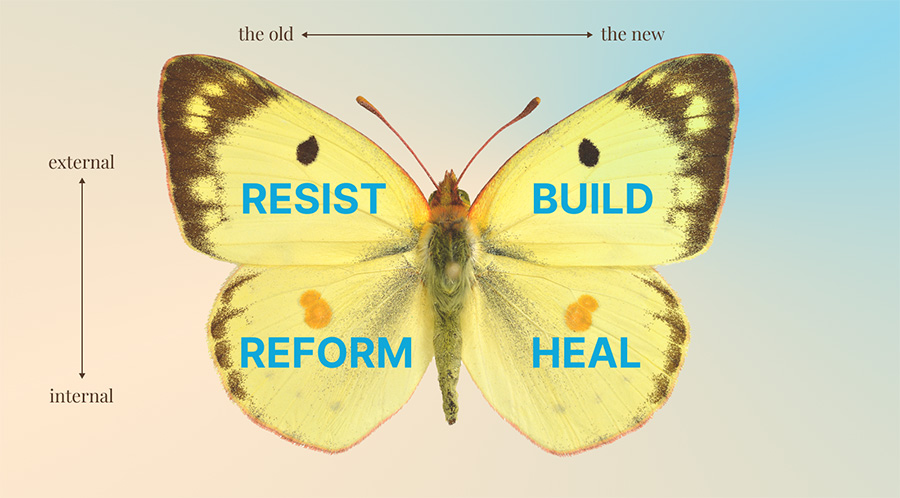
Leah Penniman, an educator, food justice activist, and co-founder of Soul Fire Farm, describes the metaphor like this:
“Butterflies cannot do what they do without all four of their wings. When we talk about social change and social transformation, these four wings are: resist, build, heal and reform”
(Bioneers, 2020).
The Resist wing stands for the direct confrontation of injustice. In the climate movement, this might look like blockading pipeline construction and the youth climate strikes. The Reform wing represents changing established institutions through traditional channels, like lobbying for a carbon tax, disclosing ESG information, and creating policies to regulate emissions. The Build wing consists of people creating new institutions and ways of living, like publicly-owned renewable utilities or community gardens. The last wing is Heal, which allows us to move forward without recreating past patterns of oppression and trauma. Healing includes activities like therapy, art, and vigils.
To understand the relationships between the wings, we can look at a few examples from the Civil Rights movement in the United States in the mid 1900s. The most well-known actions from this movement are often used to demonstrate the effectiveness of mass demonstration and civil disobedience. The Greensboro lunch counter sit-ins ended the segregation of lunch counters in over 150 cities. The Montgomery bus boycott ended the segregation of buses in almost all Southern cities. The March on Washington helped to pass the Civil Rights Act of 1964. These nonviolent civil disobedience actions all fit in the Resist wing. They pushed back against segregation and racist policies, while demanding change.
The Resist wing’s efforts both enable and push the Reform wing to advocate for and implement the change within existing institutions. For example, Black voters supported President Kennedy and helped him win the 1960 election. President Kennedy was hesitant to advance civil rights legislation, however, his staff encouraged him to appoint African Americans to high-level positions. Eventually, the Kennedy administration drafted and built bi-partisan support for the Civil Rights Act of 1964. The voters, Kennedy, and his staff were all key players in the Reform wing.
The Reform wing needs the Build wing to show new (and old) ways of being. In the Civil Rights movement, Martin Luther King insisted that his staff be multiracial, in order to practice and demonstrate that multiracial collaboration was possible. The Build wing can also support Resist efforts. During the Montgomery bus boycott, which lasted 13 months, the Black community formed their own carpooling service with over 300 cars.
Lastly, we have the Heal wing. There was art and photography, music, poetry and literature that celebrated African-Americans and also brought light to injustices they suffered. The Heal wing works in concert with the others. There was singing and chanting to raise spirits during the marches, and the marches themselves were healing. Martin Luther King wrote that nonviolent direct action transformed people and helped them find courage and dignity while living in an exploitative system.
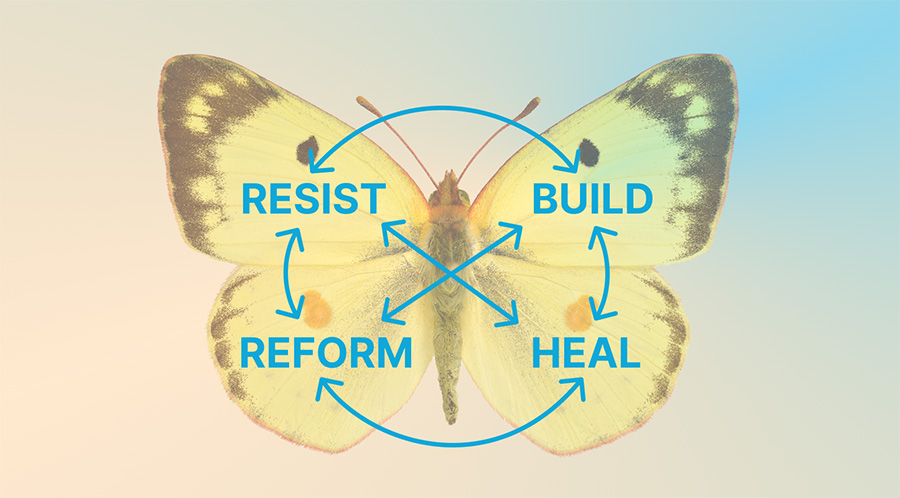
“There is no way that one individual or one organization or one strategy is going to win this. We really need to figure out how to collectively make our butterfly fly with all four wings working together.”
— Leah Penniman
Like the Civil Rights movement, the climate movement needs all four wings. Each wing has its own functions, motives, responsibilities and capabilities. The butterfly metaphor has helped me see that when we’re skeptical about a climate solution or campaign, we’re often pointing out that it is only one wing of social transformation. But when I view climate actions as part of a connected movement, I stop looking for where it falls short – I start looking for supporting connections and wings.
Testing the Butterfly
As an experiment in butterfly-thinking, I organized a discussion with activists and advocates from different climate groups. The intent was to practice envisioning our projects as the four butterfly wings working together. Modified slides are included below if you would like to try this experiment with your community.
There were 8 participants, and we had a wide range of experience in climate activism and advocacy between us. We also had our share of climate skepticism. Some were wary of shame & blame-style activism or the slowness of government change or the profit-seeking nature of clean tech. Several of us had dropped out of climate groups because of differences in strategy and values.
To start the discussion, I introduced the butterfly metaphor briefly, using the US Labor movement as an example. Then we shared what we were working on and matched climate our projects to different wings of the butterfly:
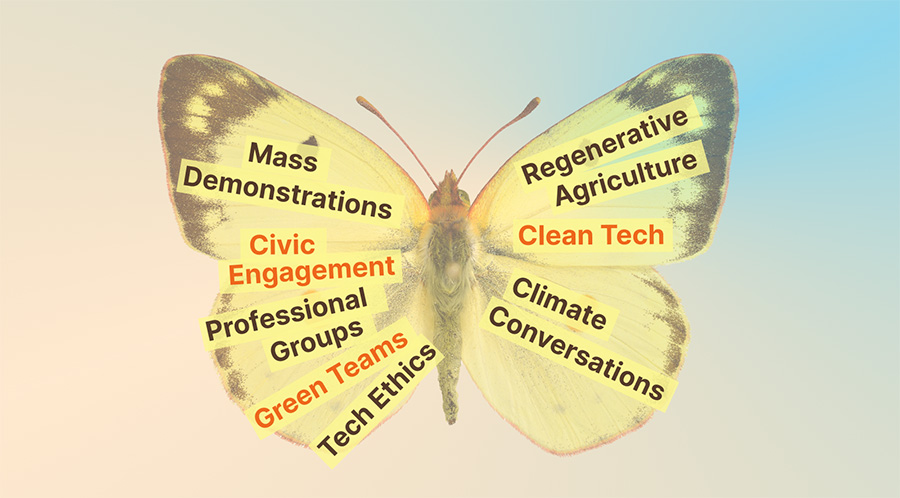
We had projects in all four wings; several people were working on multiple climate initiatives. The projects ranged from mobilizing mass demonstrations to organizing corporate green teams to investing in clean tech. The butterfly was a helpful way to orient each other’s work – we could easily connect a project to its approach to social change. The butterfly framing also made space for everyone’s project. Brand names, budget sizes, and political leanings didn’t matter. My usual skepticism was quiet. I wanted everyone’s project to succeed so that we could have a vibrant butterfly.
For the envisioning exercise, we wanted to create a story that connected all of our main projects together in a meaningful way. We wanted something more than a coalition-based campaign – where a few lead groups set the agenda and the rest sign on and amplify. We wanted to come up with a new pattern of collaborating, one that is based on our core work, and not just our membership numbers. For our story, we had a profession-based climate group (Reform), a climate discussion group (Heal & Build), a climate lobbying group (Reform), and a local regenerative agriculture group (Build).
This is our first pass:
The professional group would direct technical volunteers to the other groups to work on their website and digital platforms.

That would enable the climate conversations group to reach more people and direct participants to other climate groups. Those groups would grow in size and capacity.
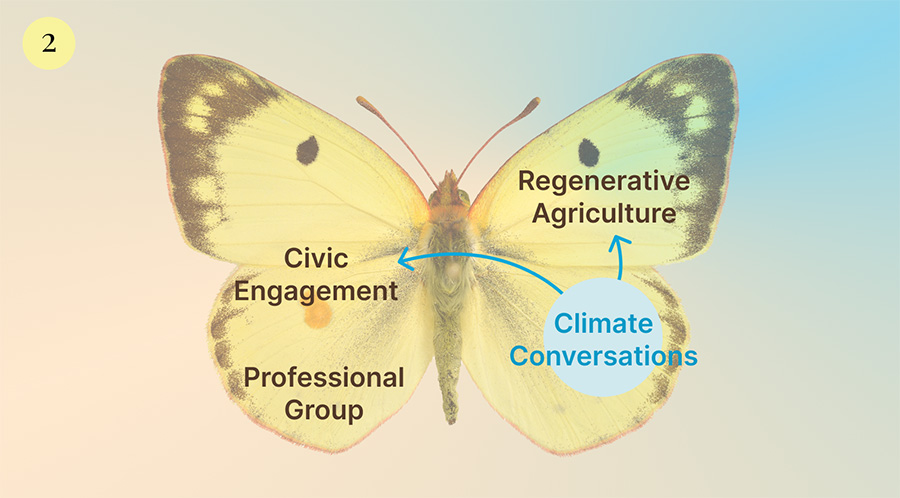
That would enable the climate conversations group to reach more people and direct participants to other climate groups. Those groups would grow in size and capacity.
This would give the regenerative agriculture group more time and resources to establish their farms.
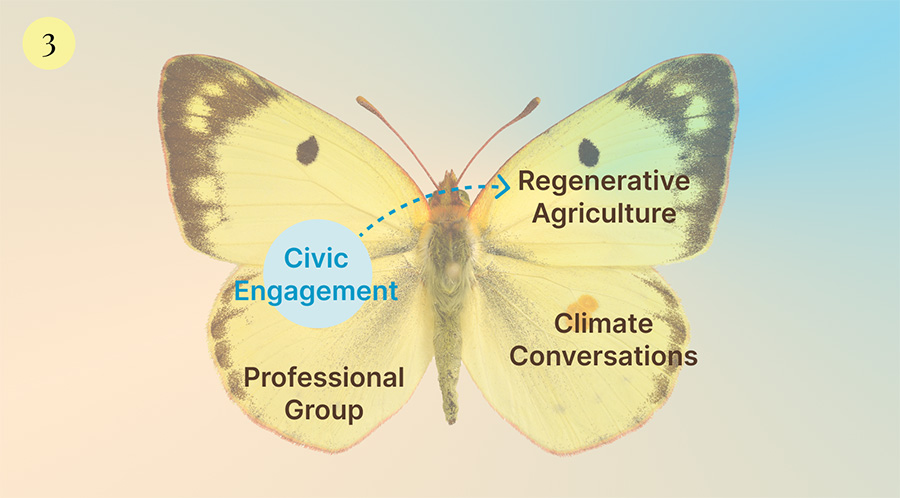
Then, when the apocalypse comes, we would all move to the farm and learn to live sustainably, in nature.
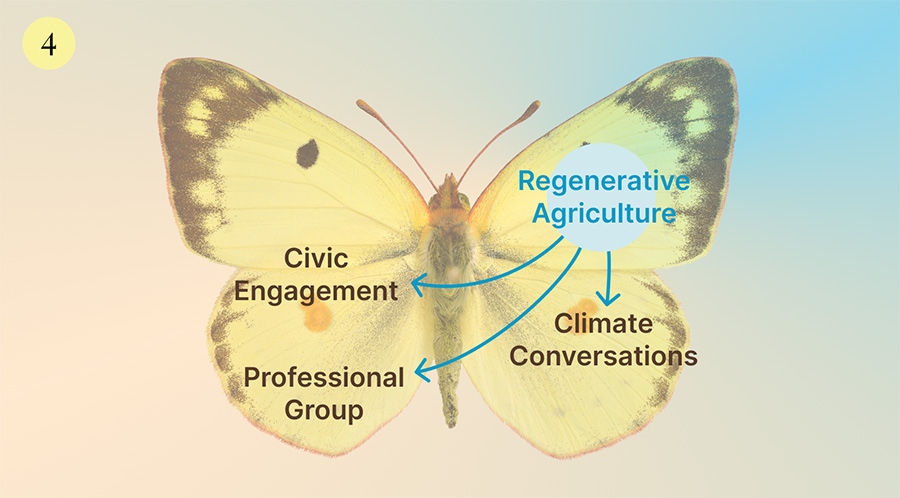
The story might sound idealistic, but it is grounded in the activities that we were already doing. If we had more time, we could have imagined many more variations. But this one story was enough to cause a shift. The mood was a little more energetic; people shared upcoming projects and invited each other to future events; we stayed past the end of the event to continue talking.
Finding New Futures: Give it a try!
This was just one experiment, one practice session. Imagine if this was the way we talked about climate initiatives all the time, if we tried to connect them together and build upon each other’s work. We can be critical and inventive at the same time.
I hope you will give this conversational/thinking exercise a try. It’s a lot more fun and rewarding than a panic-inducing doom spiral. Don’t worry about finding immediate solutions and actions to take. The intent is to view climate initiatives within a system and to practice identifying and imagining opportunities to move forward, together.

“My dream is a movement with such deep trust that we move as a murmuration, the way groups of starlings billow, dive, spin, dance collectively through the air — to avoid predators, and, it also seems, to pass the time in the most beautiful way possible… There is a right relationship, a right distance between them — too close and they crash, too far away and they can’t feel the micro-adaptations of the other bodies. Each creature is shifting direction, speed, and proximity based on the information of the other creatures’ bodies.”
– adrienne maree brown, Emergent Strategy
Day-to-day Conversations
If you notice that you’re skeptical of a climate solution or initiative, try identifying which wing of the butterfly it belongs to (Resist, Reform, Build, Heal). Then try asking questions like:
- What if this worked? How might it work? How might this work with the other wings?
- If it’s unlikely to be successful, what needs to happen or change for it to succeed?
- What might change if it only partially succeeds? What might change if it fails?
- What would I do instead? How would I do this differently? Do I have any influence to change its direction?
Organize a Butterfly Discussion
The intent of the event is to practice a different mindset. Try to encourage a shift towards openness and creativity. Help the group find new connections and common ground. Networking and building cross-group relationships are secondary, and will hopefully occur naturally.
- Slides & run of show: Google slides
- Activity: Miro board
- Tips:
- Schedule at least an hour and a half (we did one hour and needed more time)
- Participants will be skeptical about certain climate strategies. Make sure to explore those strategies – not as a form of debate, but as practice in looking for connections and possibilities.
- We offered an optional stipend to organizers outside of our community in order to include more people and perspectives.
Recommended Reading
Movements
- Emergent Strategy, adrienne maree brown
- Butterfly metaphor, from a panel discussion with Leah Penniman
- Climate Change Countermovement, interview with Robert Brulle
- After Protest: Pathways Beyond Mass Mobilization, Richard Youngs
Inspiration
- Sane Energy Project, No North Brooklyn Pipeline campaign
- SNCC Youth Organizers history of youth-led civil rights organization
- “New Phase of Civil Rights Struggle”, Martin Luther King interview
- Frances Perkins, textile workers, union members, and others who fought for workers rights
Credits
Editor: Hannah Smith
Project review & feedback: Alja Isakovic, David Packer
Facilitation: Alja Isakovic, Sandra Pallier
Illustration assistance: Brett Duboff
Special thanks go to the discussion participants for sharing and envisioning possible futures together.
Melissa Hsiung is the founder of CARL, a climate education website that empowers workers to make their jobs more sustainable. She is also a director at ClimateAction.tech, an online community of tech workers who advocate for climate action in the tech industry and practice green software design & development.

